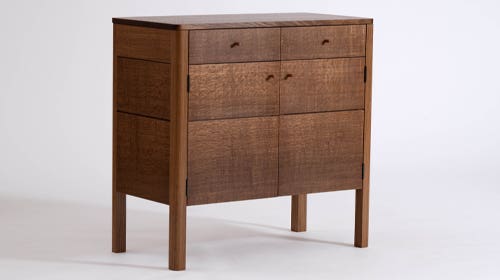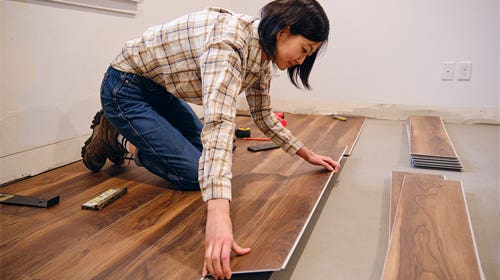New concepts spice up design competition
There were 75 finalists out of more than 300 entrants for this year’s Design Emphasis contest, a woodworking competition held in conjunction with the biennial International Woodworking and Machinery Supply…
There were 75 finalists out of more than 300 entrants for this year's Design Emphasis contest, a woodworking competition held in conjunction with the biennial International Woodworking and Machinery Supply Fair. The pieces, which are in any of six categories, will be judged at IWF 2008, to be held Aug. 20-23 at the Georgia World Congress Center in Atlanta.
The contest was open to any student enrolled in an accredited college or university and in an undergraduate furniture design course. Categories include Seating, Ready to Assemble, Contract, Case Goods, Occasional and Design Creativity. Entries will be judged on design (40 percent); manufacturing capabilities (25 percent); marketability (20 percent); and workmanship (15 percent)
While dozens of schools across the nation had students who entered, Georgia Tech dominated with 17 pieces selected for the finalist round. Alan Harp, furniture design instructor at Georgia Tech, says it's the school's strongest showing to date. The school's Industrial Design department, which has furniture design classes within, began offering the contest to students about six years ago. Participating in the contest has had a tremendous impact on attracting more students to the program, says Harp.
But while having students make the finalist list helps promote any school, Harp agrees the students are the ones whose careers will ultimately benefit.
"It helps them bulk up their resume and their portfolio," says Harp. "It gives them exposure to a greater audience and gets them to where they can see how they stack up against the other really good furniture designers that are also graduating at the same time. They get to examine themselves against their peers in the furniture design arena. It helps them understand what the industry wants to see."
There are some distinguished commonalities between many of this year's finalists. For starters, as emerging designers, they're adamant about not being limited to one particular design style. And naturally, they're determined. Those interviewed for this story say even if they don't win, they're still going to design with the same drive to succeed. Still, all certainly hope judges will take to their creativity like bait.
Robert Wylie
Rockingham Community College,
Wentworth, N.C.
Wylie was selected as a finalist in the Case category. He entered the contest in hopes of gaining more experience in terms of going to trade shows and networking with other woodworkers.
"In the long term, I want to teach high school woodworking. For the short term, I'm looking at building more furniture to get more experience before I go into teaching," says Wylie.
Last year, Wylie was a finalist at the AWFS Fair in Las Vegas, which sponsors another student design competition called Fresh Wood.
His piece for this year's IWF is a modification of a traditional Hepplewhite-style sideboard made of solid mahogany. It is about 6' long with four doors and one drawer. He incorporated modern joinery techniques, such as loose tenon construction, because it was faster.
"I really enjoy working with hand tools, and I knew this would give me the opportunity to do a lot of hand shaping and intricate details; there's a lot of stringing and inlay on the piece. I also wanted the challenge of working with the curves," says Wylie.
"With this piece, I spent more time in the design phase more than anything else. I probably put in 80 hours of drawing and CAD. I knew that I wanted to build a Federal period style sideboard, so I did a lot of research, pulled together a lot of different design styles that I like, then began drawing my piece and doing all the paperwork involved, including estimates on my labor, lumber and all of the other materials."
The most challenging part, he says, was building the coopered doors. He glued about five boards together to form each curve and then smoothed them with hand tools. The piece also features holly and ebony accents, and a good amount of mahogany and sapele.
Brittany Walsh
Georgia Tech, Atlanta
Walsh was selected as a finalist for two pieces: a coffee table in the Occasional category and a buffet in the Case category.
"My goal was to just see if I could get any piece in because this was my first experience with furniture at all. I wanted to see if I could make it to a level where I could compete with students all around the country," says Walsh.
The Georgia Tech students based their projects on what actual clients wanted and worked closely with a local branch of a large retail manufacturer. Walsh, along with her colleagues and Harp, said the students from Georgia Tech did particularly well this year because they were given a real-life scenario.
"My inspiration for the case [piece] was the Art Deco Era. I played with the style and added some curves. I tried to make it more modern with the really dark finish, knobs and pulls," says Walsh.
With her second piece, Walsh got technical using a binary code pattern for the top. She took 8'x4' planks of walnut and glued them together, and did the same with maple and purpleheart, then ran them through the planer and jointer.
"Once I finally got [the glue-ups] to the same dimensions, I took them to the table saw and cut them into 2-inch sections," says Walsh. "From there it was a little awkward because everything is at a 45-degree angle."
Walsh says she's looking forward to seeing work from others at IWF, as well as getting pointers on starting a business and finding out what kind of direction the furniture industry's going.
Alex Roberts
University of Kentucky, Lexington, Ky.
Roberts, who got a finalist slot in the Seating category for his bent lamination chair, has his degree in architecture. He plans to start his own fabrication shop one day and wants to observe his future competition at IWF. His contest piece was inspired by an English corner chair someone showed him at work.
"It inspired me to look at antique furniture and study the derivatives of modern day seating. I already had the materials I wanted to use — plywood, walnut veneer and solid stock walnut," says Roberts.
The chair is derived from the Queen Anne period but has a modern twist, as all of the patterns in it reflect modern day weapons. The chairback has multiple mirrored AK-47 assault rifles, the legs are the stocks of rifles, and the bottoms and sides feature MK2 grenades. Roberts hopes people will look at the patterns in it, and wonder why he chose them.
"I have a belief that a social commentary is something that needs to be part of everything that somebody does. It has to be part of the culture and [should] maybe even question the culture a little bit," he says.
Luke Saule
Art Center College of Design,
Pasadena, Calif.
Saule is studying product design and recently began dabbling in furniture. "Overall, I think I want to design everything and not be pigeonholed into just furniture design," he says.
His plan with entering the seating contest was to create a welcoming chair to sit in featuring winged-out armrests. His final piece, the Annex Armchair, is a very sleek and modern white leather upholstered chair with an alder wood frame and polished aluminum base.
Saule outsourced the seat and base, but oversaw the construction. In the design phase, Saule researched modern pieces that would belong in public spaces, and created concept sketches of the general shape he wanted, which he then applied to SolidWorks. In the 3-D mechanical design program, he figured out final proportions, and from there created orthographic drawings and renderings for the manufacturers.
He says his college education helped him the most with the design process. "In the beginning stages, since it was my first real furniture piece, it was a lot about proportion. [The instructors] helped me a lot with proportion, as well as overall styling of the piece."
Saule has created a metal end table to match the chair and is interested in further expanding the line.
Lacey Campbell
Savannah College of Art and Design,
Savannah, Ga.
Now in her senior year at SCAD, Campbell enters furniture design contests to build her resume, as she hopes to own her own business someday. She got a finalist spot for her game cabinet in the Case category. In classes at her school, students are asked to look at things that already exist to see what inspires them.
"I Google different words and see what type of imagery comes up. I look at furniture books and try to find inspiration around me as well, then start brainstorming, whether it's on paper or imagery," she says.
The inspiration for her cabinet was board games. The class picked words out of a hat, and she picked "dining room" and "self-contained."
She solved "self-contained" by incorporating a pull-out drawer to store the games and their pieces. With the drawer closed, the piece is suitable for the dining room and can double as a serving table.
Campbell believes the best part of the piece is the attention to detail in the tray, which has places for specific items, such as the dice and egg timer. She hopes the judges will take note, but, win or lose, her future plans aren't going to change.
"I'm still going to have the same drive that I have. I have a very deep passion for furniture, so I'll just keep pushing ahead."
Austin Rhodes
Haywood Community College, Clyde, N.C.
Rhodes, who graduated in May and joined a cooperative shop with two other furniture makers in Asheville, N.C., says he entered the Seating category because he felt up to a challenge.
"Chairs are difficult to design and make. It's a good challenge, I think, especially for a new designer and maker, because there are a lot of different techniques that need to be learned to make that piece," says Rhodes.
In building the modern chair out of cherry, Rhodes started by making templates. He claims his design style is all about saving time, so if in the future he needed to make a whole set for a dining room, he could quickly redo all the pieces at once, rather than separately.
"I have a degree in architecture design. I like to hand-draw everything full scale — it helps me to work out all the connections and joints and angles before I get into making the piece so there's not so much flying by the seat of my pants. It's easier to have a plan to work from."
But designing the chair was still the most difficult phase, especially in deciding where to simplify it to prevent it from looking bulky.
"The highlight of the piece is the part that curves back," says Rhodes. "It's bolted to the bottom; it actually flexes a little. I think it turned out nicely. I had to make a form and mold multiple layers of veneer and press them together in a vacuum press. It's comfortable for most average-sized people."
In the spirit of competition, Rhodes says it doesn't matter if he wins.
"I'm going to try to enter as many competitions as I can, but I know it's all very subjective. I'm sure there were some very nice pieces that didn't get accepted [into Design Emphasis], so I'm just honored to be a finalist."







